
Nasturtium: planting, sowing, caring for
Contents
Nasturtium in a nutshell
- Climbing, trailing or dwarf, annual or perennial, the nasturtium is an easy-going and versatile flower that blooms abundantly all summer, even in pots from which it will exuberantly escape
- This frost-sensitive plant fears only frost and is most often grown as an annual in our regions, although there are a few lesser-known perennial species!
- Its trumpet-shaped flowers and lovely round leaves add a touch of exoticism to borders or any support provided
- Impossible to miss, it grows easily everywhere: it’s the ideal plant for beginner gardeners and children!
- Leaves, flower buds and flowers are edible and can enhance summer salads!
A word from our expert
Nasturtium has everything to please! It is very easy to sow or plant, grows quickly, blooms from June until the first frosts, spreads freely to cover the soil, dress a border, or climb up any support. In short, nasturtium is versatile!
With its beautiful round leaves over which proudly emerge flowers in bold colours of red, orange, and yellow, it always brings a lot of freshness and cheerfulness.
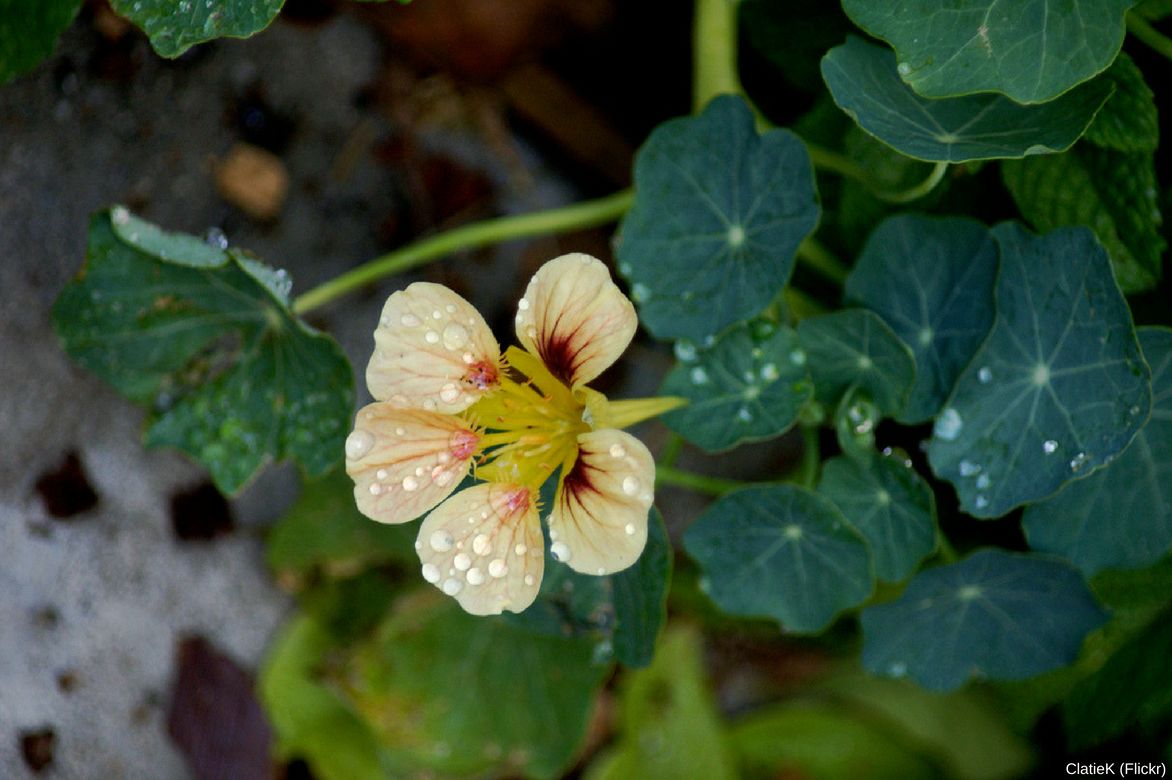
Nasturtium flower in an irresistible colour.
The icing on the cake is that its edible flowers and leaves are delicious in salads and its flower buds can be pickled in vinegar like capers!
Alongside annual climbing nasturtiums like the Greater Nasturtium (Tropaeolum majus) which needs to be reseeded each year, there are perennial nasturtiums unjustly overlooked, such as the Tuberous Nasturtium which is grown like a potato, Tropaeolum ciliatum, a frost-tender nasturtium, and Tropaeolum speciosum, the Elegant Nasturtium, which should be grown in not too cold regions.
All are easy to sow or plant and thrive in the sun, content with any soil, even poor.
As a bonus, nasturtium is one of the essential plants for the vegetable garden: it is a real aphid trap that attracts them like a magnet!
Do not miss out on this lovely plant within everyone’s reach and indulge in our unique collection of annual nasturtium seeds and plug plants of nasturtium!
Description and Botany
“`html
Botanical data
- Latin name Tropaeolum
- Family Tropaeolaceae
- Common name Nasturtium
- Flowering From June to autumn
- Height 0.10 to 4 m
- Exposure Sun, partial shade
- Soil type All, well-drained
- Hardiness -5°C to -15°C depending on species
The Nasturtium or Tropaeolum is a annual or perennial plant native to Central and South America, belonging to the Tropaeolaceae family. There are 80 to 90 species growing naturally in cool mountainous areas. Two types of nasturtiums are distinguished: dwarf and climbing.
The large nasturtium (tropaeolum majus), introduced to Europe as a vegetable plant under the name “Peruvian cress”, is the most well-known and widely cultivated in our gardens. It has given rise to numerous varieties just like Tropaeolum minus and Tropaeolum majus nanum (a semi-dwarf form), the dwarf nasturtiums.
Among the nasturtiums grown as annuals in our climates, we sometimes encounter the Canary Nasturtium (Tropaeolum peregrinum), an unusual variety with foliage and flowering very different from its cousins.
However, the genus includes some perennial species unjustly overlooked in France, such as the tuberous nasturtium (Tropaeolum tuberosum), which is a botanical species, an ancient vegetable cultivated in the Andes for its edible tuber. The tropaeolum ciliatum is a non-hardy bulbous nasturtium. Tropaeolum speciosum, the Elegant Nasturtium, is a climbing perennial from Chile that is much more delicate to cultivate. The tricolour nasturtium (Tropaeolum tricolorum) is another climbing perennial with early spring flowering.
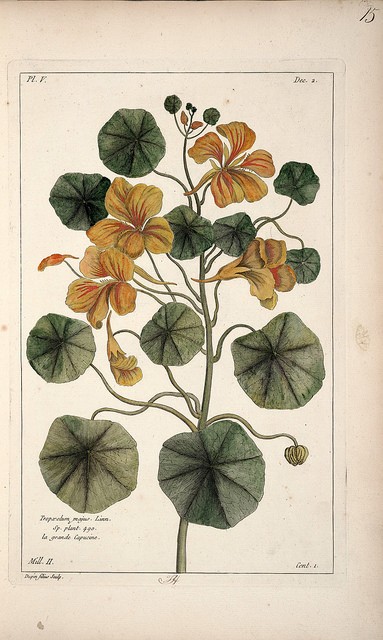
Tropaeolum majus – botanical illustration
The size varies according to species; it can be dwarf or climbing and twining. The large Nasturtium (tropaeolum majus) or “garden nasturtium”, the tuberous nasturtium, and Tropaeolum peregrinum are climbing plants that can easily reach 2.50 m high and more within a few months. Tropaeolum ciliatum can climb at least up to 3 to 4 m, while dwarf varieties like Tropaeolum minus have a compact habit and will not exceed 40 cm in height but will form low clumps up to 1.50 m in spread.
Whether annual or perennial, they all have a rapid growth.
The petiole of the leaves twines to allow them to climb readily on any supports provided (fences, trellises, branches…), without gardener intervention, nasturtiums will spread as a groundcover in all terrains. In pots, it will be an elegant trailing plant.
The perennial nasturtium (like the tuberous nasturtium much appreciated in cooking) is a rhizomatous plant that develops from large fleshy tubers that are sometimes bumpy, pearly white or yellow marked with purple. Like potatoes, it forms clusters that multiply quickly and can be consumed cooked, as crudités or preserved like pickles.
In annual species, the shallow root system is not permanent: the small tubers the size of peppercorns die quickly when winter sets in. However, in regions where it rarely freezes, nasturtiums self-seed easily from year to year.
The nasturtium stretches its slender and brittle stems that climb by wrapping around any support, thanks to the long petioles of the leaves, somewhat like clematis do. Most nasturtiums have a typical foliage: beautiful leaves that are deciduous or semi-evergreen in mild climates, 2 to 7 cm in diameter, all rounded (peltate) with undulating margins, borne on a central petiole and divided into 5 to 7 rounded lobes.
In Tropaeolum speciosum and Tropaeolum ciliatum, they are palmate and divided into rounded, pointed, and uneven lobes.
The Canary Nasturtium is distinguished from its cousins by its original medium green foliage composed of palmatisect leaves, like fig leaves.
If they are matte, acid green, very dark bronze to blue-grey green with fine lighter veins for the most part. Some varieties like ‘Alaska’ feature variegated foliage, marbled with cream.
The tender young leaves of nasturtiums are edible and can be consumed raw: they have a pronounced peppery flavour quite similar to rocket and cress. Learn more in our tutorial How to use nasturtium in cooking?
 The flowers of nasturtiums offer a wide range of colours and petal shapes that are out of the ordinary: Tropaeolum ‘Banana Split’, Tropaeolum ‘Scarlet Emperor’, Tropaeolum ‘Empress of India’, Tropaeolum ‘Phoenix’, Tropaeolum ‘Milkmaid’.
The flowers of nasturtiums offer a wide range of colours and petal shapes that are out of the ordinary: Tropaeolum ‘Banana Split’, Tropaeolum ‘Scarlet Emperor’, Tropaeolum ‘Empress of India’, Tropaeolum ‘Phoenix’, Tropaeolum ‘Milkmaid’.
Particularly graphic, these always fresh leaves bring a certain lushness to the plant and serve as a backdrop for the exotic colours and shapes of the flowers. The Nasturtium is appreciated for its original and long flowering that extends continuously from May to September, sometimes until the first frosts.
The flowers proudly rise above the generous foliage; depending on the species, they are sometimes masked by the abundance of leaves.
The pretty funnel-shaped flowers measuring 1 to 7 cm in diameter bloom singly in the axils of the leaves. In most nasturtiums, they are formed of 5 rounded petals with fine, irregular, often crumpled attachments. They can be single or double. Enclosed by a calyx with a long spur pointing backwards, they evoke the hood of the habit of Capuchin monks, hence the name nasturtium.
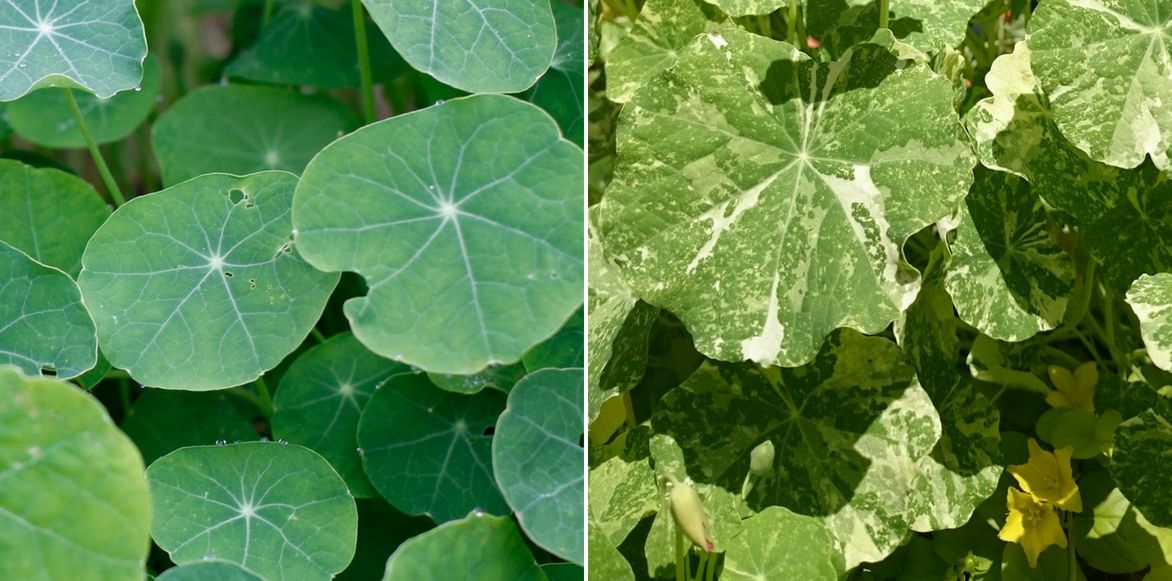 Foliage of nasturtiums: green or variegated
Foliage of nasturtiums: green or variegated
In some varieties, the shape of the petals differs. Tropaeolum minus ‘Phoenix has very cut and ciliate petals resembling flames. The Canary Nasturtium displays feathery flowers with prominent stamens resembling golden butterflies, while in the tuberous nasturtium, the flowers are tubular and borne on a long curved peduncle. The Tropaeolum tricolor bears small blood-red flowers with a yellow centre surrounded by a purple ring.
While most have vibrant colours in shades of fire, ranging from classic bright vermilion to deep red, peach orange, cream white reminiscent of fresh butter to canary yellow, there are many varieties that differ by the appearance of the corolla, whether solid, spotted, or delicately veined.
Some nasturtium flowers have an exceptional colour; ‘Black Velvet’ is a nearly black mahogany, while ‘Chameleon’ reveals a multitude of flowers evolving from cream splashed with red, reminiscent of certain orchids.
They exude a light daffodil fragrance, more pronounced in the morning and evening. Their spurs filled with nectar attract pollinating insects throughout the season.
Edible, these flowers rich in vitamin C add a colourful, vitamin-packed touch to salads and have a peppery and tangy flavour, and can be enjoyed in savoury fritters!
After flowering, they transform into globose fruits with three chambers (triakènes) that are striated and contain a large seed the size of a chickpea, which can be pickled in vinegar like capers, just like the flower buds.
 Fruit of the nasturtium.
Fruit of the nasturtium.
Vigorous, the annual nasturtium thrives in all soils, even poor ones. It grows in the sun but can tolerate light shade. It is incredibly easy to cultivate, making it an ideal plant for beginner gardeners and children!
Non-hardy perennial species (Capucine speciosum, tuberous nasturtium) are usually grown in our country as annuals to be stored in a greenhouse at the first frosts or reserved for regions with mild winters, due to their low frost resistance (-10°C maximum).
The Nasturtium develops very quickly to cover a fence, arbour, or trellis in just a few weeks. Left free, without available support, the climbing Nasturtium will form a unique groundcover, in borders or in the middle of an annual bed. You can also grow it in pots or hanging baskets where it will be a flamboyant trailing plant on terraces and balconies.
The large nasturtium is used in cosmetics for its toning properties and is included in hair care products.
“`
Main species and varieties
When we talk about nasturtiums, we immediately think of the non-hardy annual nasturtiums like our common great nasturtium (Tropaeolum majus), known for its red, yellow, or orange hooded flowers and its beautiful round leaves, bright green or bluish green that are so characteristic. It has given rise to the very vigorous and floriferous Lobb Hybrid, with numerous varieties, some of which remain dwarf, others are creeping, as well as the “Race Alaska” series, indispensable dwarf annuals.
Less commonly cultivated, the Canary nasturtium (Tropaeolum peregrinum) is also a beautiful vigorous climbing annual that is very original and very easy to grow.
The perennial species like the tuberous nasturtium (grown for its edible tuber), Tropaeolum speciosum, Tropaeolum tricolorum, and Tropaeolum ciliatum (the hardiest) are unjustly overlooked. Less common in our gardens, they are all just as floriferous but more delicate to cultivate as they are semi-hardy and will only survive in the ground in mild climates.
Climbing and voluble sometimes up to 4 m high or adorable dwarf nasturtium, queen of borders and summer pots, the choice of a nasturtium depends on the intended use as well as your climate.
Alongside the famous Tropaeolum majus ‘Empress of India’ with its scarlet flowers, annual nasturtiums come in numerous varieties that differ by the colour of their solid or veined flowers ranging from mahogany to cream-white. Some, like Tropaeolum majus ‘Alaska’, even stand out with their very bright variegated white foliage.
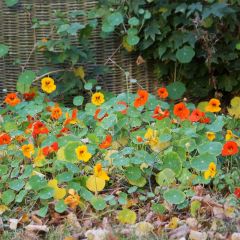
Tropaeolum Tom Thumb - Dwarf Nasturtium seeds in a mix
- Flowering time July to November
- Height at maturity 35 cm
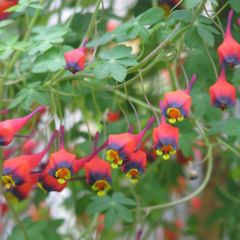
Tropaeolum tricolor
- Flowering time May to August
- Height at maturity 2 m
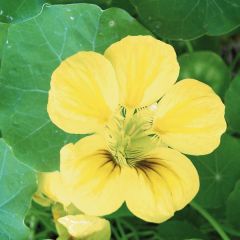
Tropaeolum ciliatum - Yellow Flame Flower
- Flowering time August, September
- Height at maturity 4 m

Tropaeolum majus - Nasturtium Alaska Mix Seeds
- Flowering time July to November
- Height at maturity 30 cm

Tropaeolum majus 'Red Wonder'
- Flowering time June to November
- Height at maturity 2 m

Tropaeolum speciosum
- Flowering time August to November
- Height at maturity 3 m
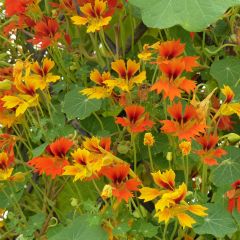
Dwarf Nasturtium Phoenix Seeds - Tropaeolum minus
- Flowering time July to November
- Height at maturity 30 cm

Tropaeolum tuberosum Ken Aslet
- Flowering time August to October
- Height at maturity 2 m

Tropaeolum majus Cream Troika - Nasturtium Seeds
- Flowering time July to October
- Height at maturity 20 cm
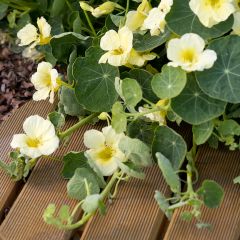
Tropaeolum majus Milkmaid - Nasturtium
- Flowering time July to November
- Height at maturity 30 cm
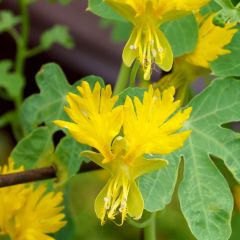
Tropaeolum peregrinum - Canary Naked Seeds
- Flowering time July to November
- Height at maturity 30 cm
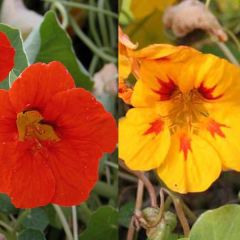
Collection of 5 Nasturtiums (Tropaeolum majus)
- Flowering time June to November
- Height at maturity 2 m
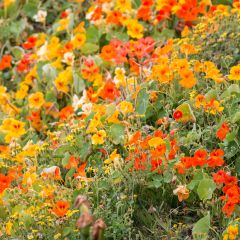
Tropaeolum majus Single-Flowered Mix - Trailing Nasturtium Organic Seeds
- Flowering time July to November
- Height at maturity 2,50 m
Discover other Nasturtium
View all →
Available in 1 sizes
Available in 0 sizes
Available in 1 sizes
Available in 1 sizes
Available in 1 sizes
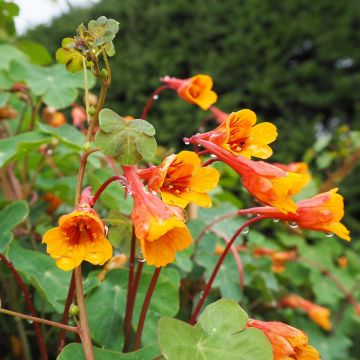
Available in 1 sizes

Available in 1 sizes
Available in 1 sizes
Available in 1 sizes
Available in 1 sizes
Planting
Where to Plant and Sow Nasturtiums
Most nasturtiums do not tolerate frost, which is why, in our climates, they are grown as annuals in open ground. In colder regions, they will need to be reseeded or replanted in the following spring. In areas with mild winters, nasturtiums will self-seed naturally from year to year very easily.
Some non-hardy perennial species like the Elegant Nasturtium (Tropaeolum speciosum) can be grown in open ground wherever frost is not too severe (down to -5°C) or in a heated greenhouse in other regions where you can cultivate it all year round.
Tropaeolum ciliatum is one of the few frost-resistant nasturtiums, hardy down to -15°C, which can remain in place throughout winter: it will regrow from the base if the aerial parts have been damaged by winter. This species also marks a summer dormancy, losing its foliage but will be magnificent again by autumn.
The Tuberous Nasturtium is not very hardy and must be dug up and stored before the first frosts, like a Dahlia.
Unfussy, nasturtiums grow quickly and well in full sun but can tolerate light shade, sheltered from strong winds (its stems are brittle), in any type of soil. They prefer ordinary soil; overly rich soil would encourage leaf development at the expense of flowers.
Canary Nasturtium and Elegant Nasturtium will bloom profusely if their roots are kept moist and their young shoots in full sun.
Very floriferous and fast-growing, they can reach 2 m in a single summer, making nasturtiums an excellent choice as climbers, as well as ground cover. In open ground, when not guided on a support, they will form a beautiful bushy mass in the foreground of a flowerbed, in a border, or over a low wall.
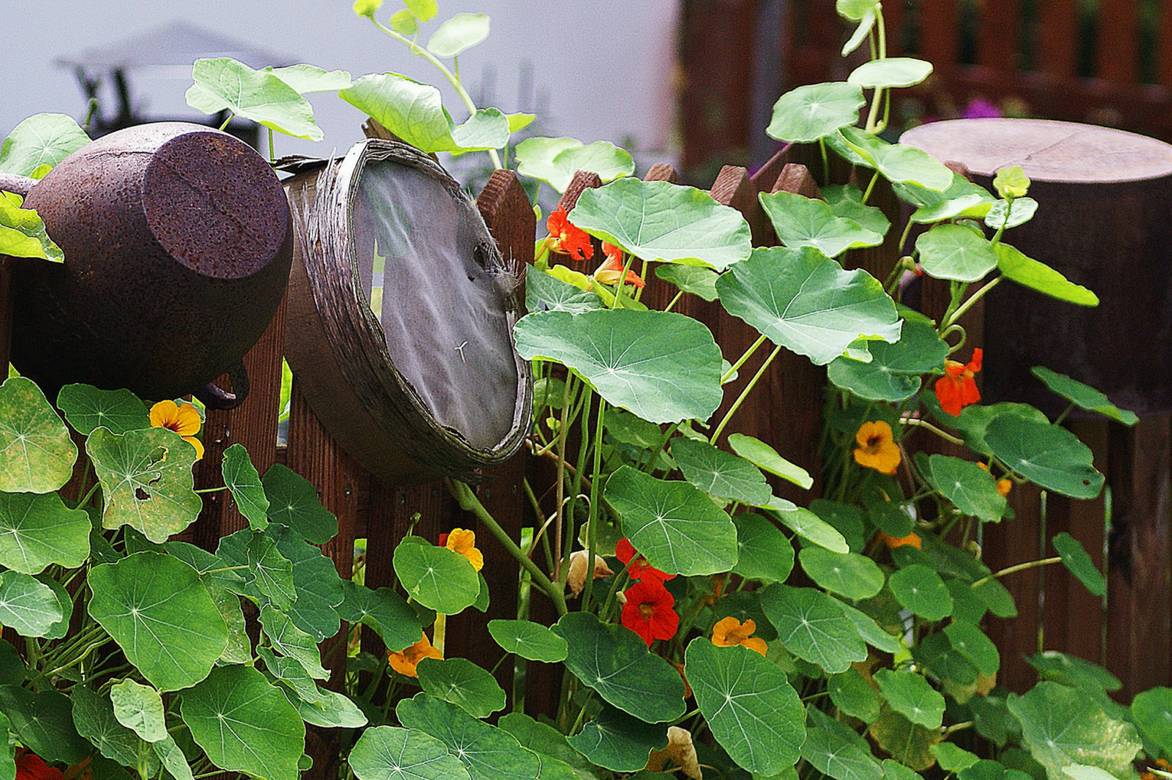
Nasturtiums beautifully adorn a wooden fence.
Climbing annual nasturtiums are perfect for quickly dressing up a trellis in an original way, flowering a fence, a gazebo, or pergola with elegance.
Dwarf varieties will quickly form a wide carpet, create flowering borders, and can also be grown in pots, window boxes, or hanging baskets, from which they will cascade with leaves and flowers.
Edible, nasturtiums also find their place in vegetable gardens, where they have the added benefit of attracting aphids away from your vegetables!
When to Plant Nasturtiums?
Plant our young nasturtium plug plants and tubers in open ground, only when the risk of frost has passed and the soil is well warmed, from late April to May.
How to Plant Nasturtiums
Planting in Open Ground with Our Nasturtium Plug Plants
Our green plants in packs of 5 plug plants are sturdy enough to be planted in open ground as soon as the risk of frost has definitely passed. In the meantime, pre-cultivate them in pots in a warm, bright place to accelerate their growth. Space the plants about 50 cm to 1 m apart for climbing species and 30 cm for dwarf nasturtiums.
Provide a support for climbing nasturtiums at the time of planting around which they can climb, but you can also let them cover the ground if you have enough space.
- Dig a hole 2 to 3 times wider than the root ball
- Spread a handful of gravel to aid drainage
- Place the plug plant in the centre of the hole, with the collar level with the soil
- Backfill with the excavated soil mixed with a bit of potting soil
- Firm down with your foot
- Water regularly until established, then only water in case of prolonged drought
Planting Tuberous Nasturtium Bulbs
The tuberous nasturtium is a very ancient vegetable with an astonishing flavour, as well as being a beautiful plant! It is suitable for the vegetable garden. The harvest of the tubers occurs 6 to 7 months after planting, in autumn. Delivered as bulbs, the Tuberous Nasturtium and Tropaeolum ciliatum can be planted in pots or open ground as soon as frost is no longer a concern, from April to May depending on the climate. The Tropaeolum ciliatum should be left in place. They will flower after one year of cultivation. A bit more demanding than annual nasturtiums, they prefer cool, light, loose, well-drained soil.
- Plant the bulbs 10 cm deep in well-prepared soil enriched with potting soil
- Water thoroughly at planting
- Lift the tuberous nasturtium bulbs before frost and store them in a frost-free place in soil or potting mix
Planting Nasturtiums in Pots
All annual nasturtiums and some non-hardy perennial species are suitable for pot or hanging basket cultivation. Growing nasturtiums is as easy in pots as in open ground. Dwarf or semi-dwarf forms are particularly well-suited. Frost-sensitive perennial species will be stored away before the first frosts or kept in a warm conservatory throughout the year.
- Plant in a rich, well-draining mix consisting of 1/3 geranium potting soil, 1/3 fine gravel, and 1/3 garden soil
- Support the stems of climbing varieties if necessary
- Water generously, keeping the substrate always slightly moist
- Fertilise regularly every 8 days
- Place in full sun
- In autumn, reduce watering
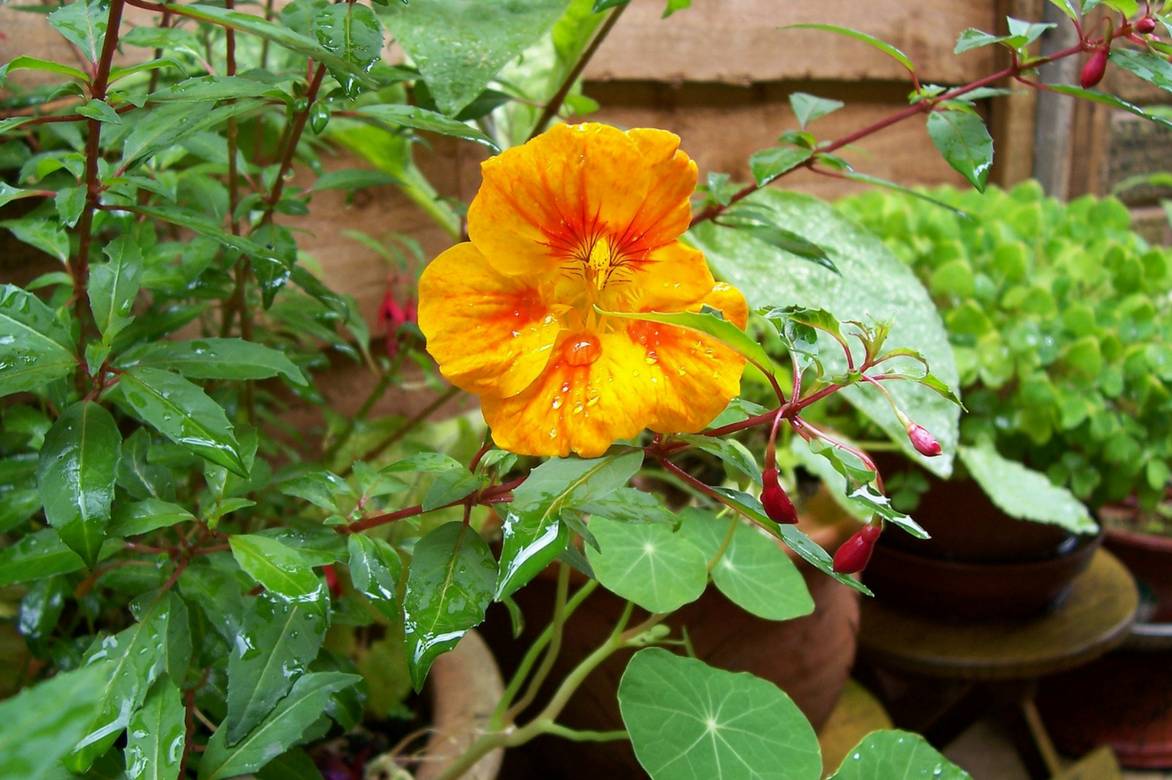 Nasturtium grown in a pot, alongside a Fuchsia.
Nasturtium grown in a pot, alongside a Fuchsia.
→ Discover our advice sheet on 6 climbers to grow in pots on a west-facing balcony
Read also
Planting annualsWhen and how to sow and germinate nasturtium seeds
When to Sow Nasturtium Seeds?
Nasturtium seeds can be sown in warmth between 13 and 16°C, starting from February (or in September) in pots or trays, or directly outdoors in their final position, from March to May.
Under Shelter
Early sowings allow for beautiful young plants for the lovely season. Choose from our unique collection of nasturtium seeds!
- In March-April, under shelter at a temperature of 15-20 °C, sow 3 to 5 seeds per pot in a special moist, draining seed compost
- Only bury the seeds 2 cm deep and cover with a thin layer of compost
- Place the sowings under a mini greenhouse or enclose them in a plastic bag
- Lightly press down and keep in light until germination
- After 3 weeks, transplant the young plants into trays or 8 cm pots
- In May, when the soil is warmed and the risk of frost has passed, plant the young plants in the garden, in pots or window boxes with good compost
- Provide support if you want them to climb
Sow Nasturtium Seeds Directly in the Ground
From late April to May, after the frosts and in warm soil, sowing nasturtium seeds is child’s play! Sow in full sun on well-drained, well-prepared soil.
- Sow in clusters of 4 or 5 seeds at 6 mm deep in the same hole, spaced 30 cm apart, or in rows spaced 30 cm apart
- Cover the seeds with about ten centimetres of soil without compacting too much
- Water the soil regularly and lightly to aid germination (between 7 to 12 days)
- Thin out to keep only one vigorous plant every 30 cm
→ Also check out our tutorial: How to Sow Nasturtiums?
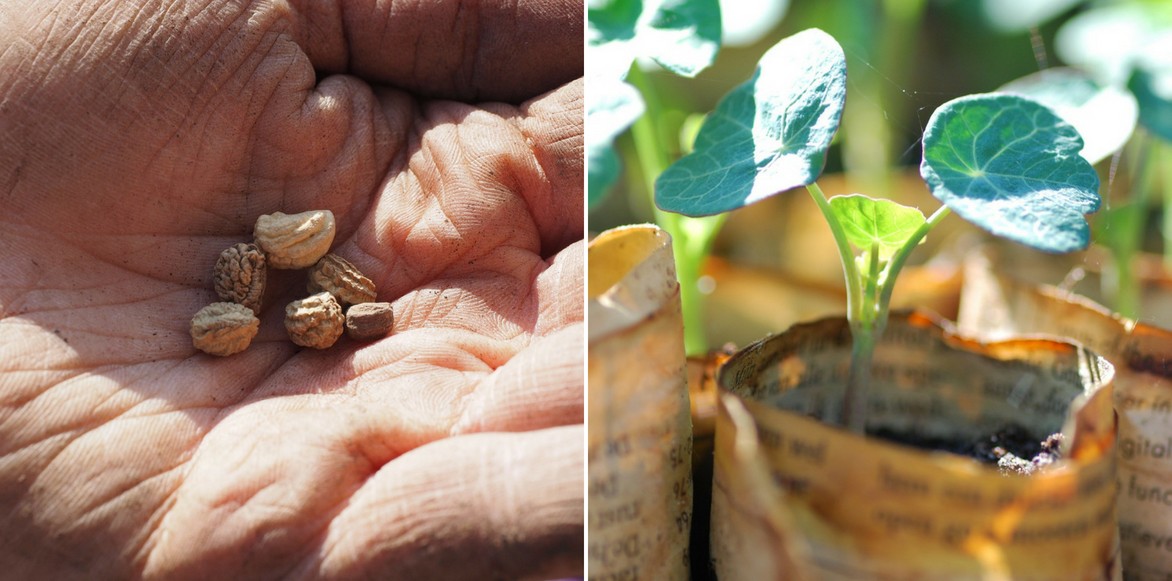
Nasturtium seeds and sowings.
Maintenance and Care
The annual nasturtium really requires little maintenance, only fearing severe frosts. It dies at the first chill. Its minimal requirements make it an easy plant for amateur gardeners and children.
From the beginning of autumn, pull up the dried and yellowing clumps after flowering. Take the opportunity to collect the seeds, which you can sow again the following spring.
Replant nasturtium plants each year, unless you have self-seeded plants, which are common with these easy-to-grow annuals. You will only need to remove the overcrowded plants.
For climbing varieties, stake your plants as soon as they are planted in the ground or in pots: their growth is very rapid, and they can gain 30 cm per week.
Water regularly to help the plant establish; afterwards, only water during periods of severe drought.
Regularly remove faded flowers to encourage a second flowering.
Keep an eye on the development of perennial nasturtiums left in the ground in mild climates, as they can become invasive and spread everywhere: after flowering, simply prune the stems when they start to spread too much.
Water potted nasturtiums more frequently.
As winter approaches, store perennial nasturtiums grown in pots in a greenhouse or conservatory where the temperature does not drop below 10°C.
For the tuberous nasturtium, increase the harvest of tubers by hilling the stems much like you would for a potato plant. Pull up the bulbs at the first frosts, as they cannot withstand temperatures below -5°C, and store them frost-free, in a cellar in sand or fresh potting soil to prevent dehydration.
Pests and potential diseases
The nasturtium is often the target of black aphids that it irresistibly attracts, causing them to abandon all nearby plants. It is an organic aphid trap. It is used as a “trap plant” in the vegetable garden near vegetable plants or in the garden around roses to naturally divert attention. Make diluted black soap sprays to eliminate aphids if you find their presence unsightly, and follow our tips for natural control against these unwanted pests.
The tuberous nasturtium, as well as the cilium nasturtium, are not afraid of aphids.
Slugs love the young tender leaves; discover our slug solutions!
It also attracts the caterpillars of the cabbage white, which burrow into the leaves. Make tansy decoctions to eliminate them.

Cabbage white caterpillars feast on nasturtium leaves.
Multiplication
The annual nasturtiums self-seed here and there in regions where it does not freeze severely. You can also collect the seeds in autumn, let them dry until they are shrivelled, and then re-sow them the following spring. It is also possible to try taking some cuttings of nasturtium in August or September.
Taking a cutting of nasturtium
- Choose healthy stems about ten centimetres long
- Plant them in a tray with potting soil
- Cover with plastic
- Keep the cuttings protected from frost in a greenhouse or conservatory
- Transplant in the following spring
Associating nasturtiums
Climbing or creeping, nasturtium is a beautiful plant with warm and vibrant colours that adapts to all desires, in the ground or in pots. It adds an exotic touch to the strictest displays in just a few weeks. It is appreciated in all gardens for its exuberance, its lovely graphic foliage, and its long flowering in fiery colours that blend beautifully with the foliage and flowers of its neighbours.
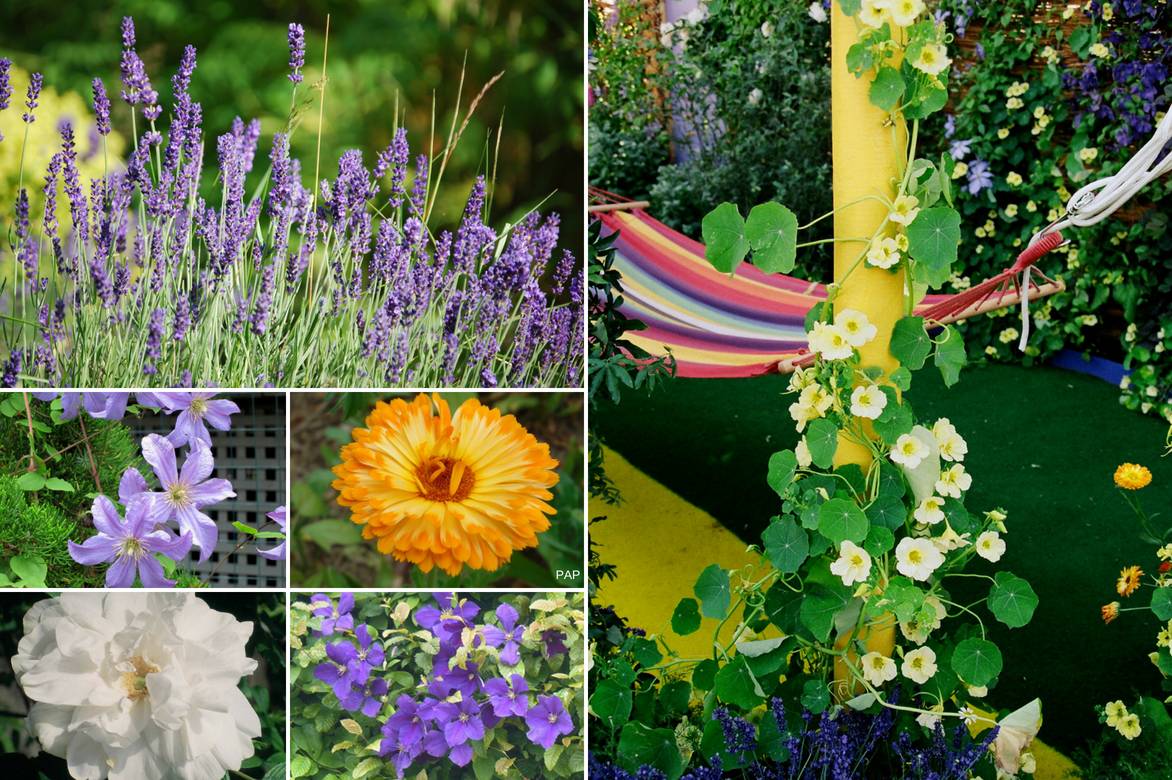
An example of pairing: pale yellow nasturtium like Tropaeolum majus ‘Milkmaid’, Lavandula angustifolia ‘Hidcote’, Clematis ‘Prince Charles’, Calendula officinalis, rose ‘Blanc Double de Coubert’ and Clematis jackmanii.
Its always vibrant colours are essential in summer in all flower beds, colourful mixed borders, pots, and even in the vegetable garden where it pairs well with other companions in warm tones such as red, salmon, peach, apricot…
Left to its own devices, to dress a path, it will form a lush and original flowering carpet alongside a Black-eyed Susan or a hardy geranium, at the foot of bushes like berberis, a rose, or a mock orange.
In beds of summer flowering perennials or annuals, it will be paired with flamboyant Echinacea, Helenium, cosmos, yarrow, vigorous cannas, cordylines, or even gladioli around which it will delicately twine.
It pairs well with other original climbers, such as Eccremocarpus scaber, Cobaea scandens, Bignonia, or Sollya heterophylla, to create a charming exotic mix.
With climbing asarina, morning glories, and both perennial and annual sweet peas, they will quickly climb a small trellis or arch.
For an effective combination, mix nasturtiums together; the dwarf varieties will cover the base of a Canary nasturtium throughout the summer.
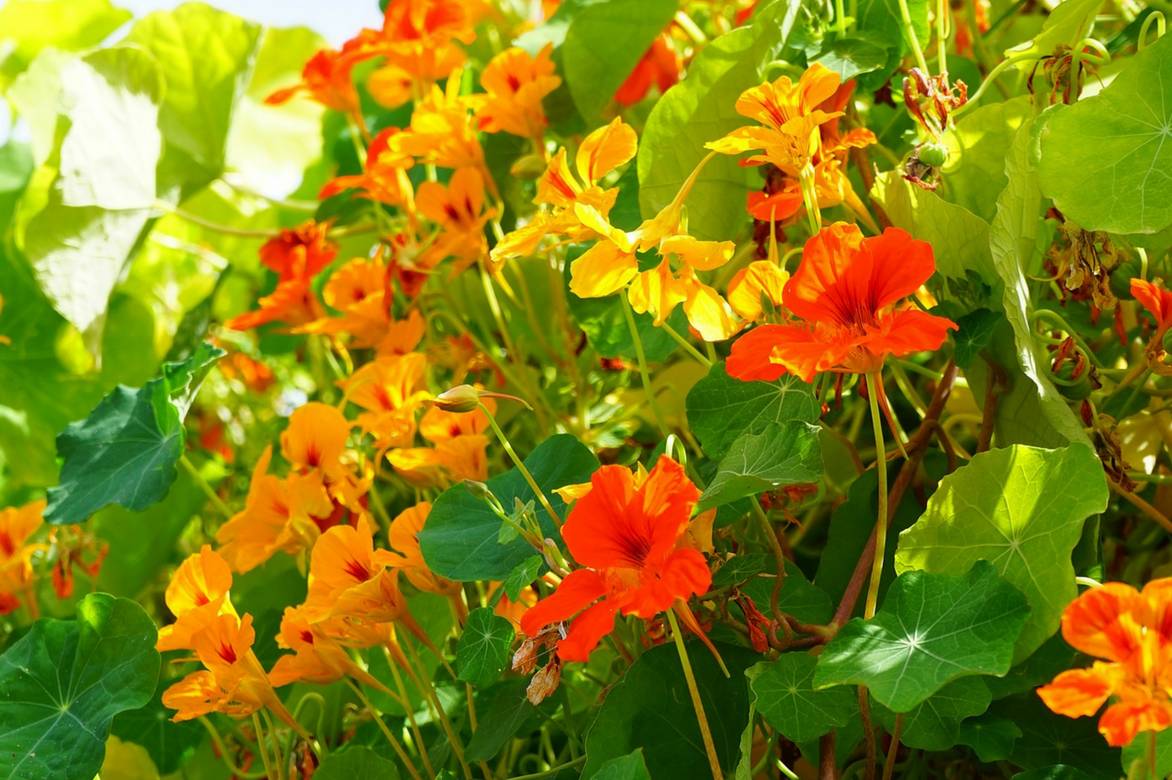
Pair nasturtiums together for a lovely mix of colours
The beautifully variegated white-cream foliage of nasturtium Tropaeolum majus series ‘Alaska’ will pair well with a cultivar of Helichrysum petiolare, a coleus, Nicotiana, and marigolds.
The spectacular garlands of Tropaeolum speciosum will adorn a hedge of dark foliage such as that of conifers like yew.
For a flowering summer with fragrant and colourful salads at hand, not far from the kitchen along a path, at the edge of a terrace or in an organic vegetable garden, pair dwarf nasturtiums with a peppery taste with borage and plant them at the base of a fennel vulgare or officinalis.
Nasturtium also makes a great impact in a hanging basket or pot alongside petunias, ivy geraniums, Alyssum, or Mandevilla.
Useful resources
- Discover our ideas for associating nasturtiums
- Eating flowers has become a real culinary trend! What are the best edible flowers?
- All our tips for effectively and naturally combating aphids
- Discover Mickaël’s video tips to master climbing nasturtium
- An original recipe: How to make nasturtium capers with Ingrid!
- Discover Olivier’s favourite: nasturtium, an essential flower in gardens
- Grow nasturtium in pots for abundant flowers!
- Our article: Invasive plant: should we be afraid of Chilean nasturtium?
- Subscribe!
- Contents
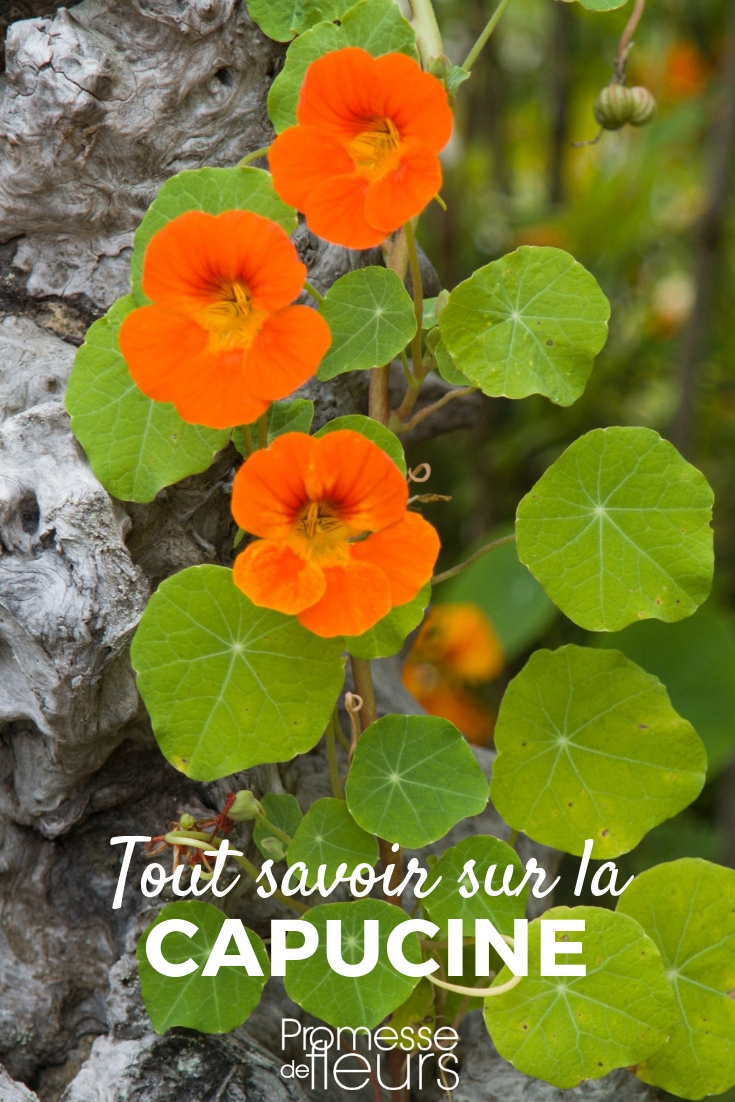
































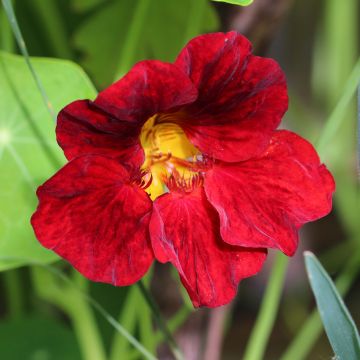

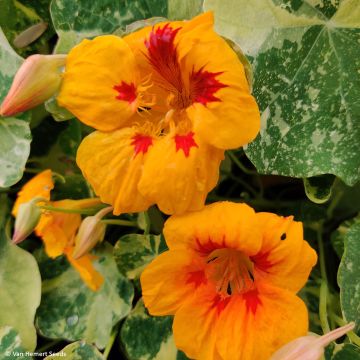
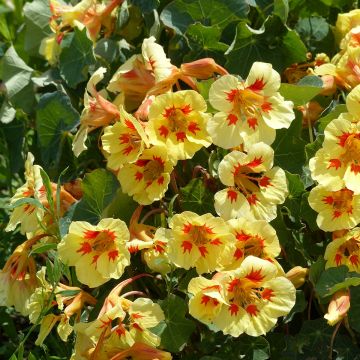
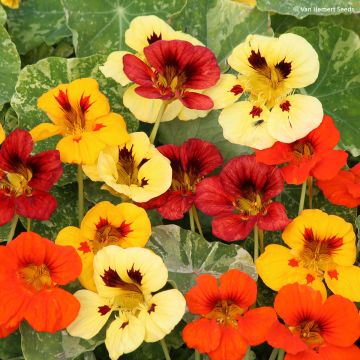

Comments